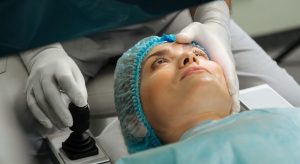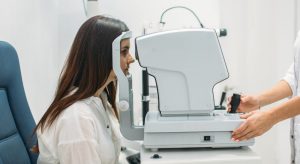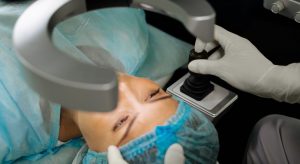LASEK Surgery After Previous Laser or Lens Surgery: Is It Possible?

If you’ve had LASIK, PRK, SMILE, or even lens surgery, and you’re now noticing changes in your vision, you may be wondering whether LASEK is an option for you. Maybe your prescription has shifted slightly over the years, you feel like your vision isn’t as sharp as it used to be, or you’re experiencing age-related changes that your original treatment didn’t fully address. It’s completely normal to ask whether a second procedure can help fine-tune your vision.
A lot of people assume that once you’ve had laser or lens surgery, additional laser treatments are off the table but that’s not true. In many cases, LASEK is actually the safest enhancement option because it doesn’t involve creating or lifting a flap, and it works well on eyes that have already been reshaped or treated before.
But enhancement surgery isn’t something surgeons take lightly. Every eye is different, and every previous procedure leaves its own “footprint” on the cornea. This is why the decision requires careful evaluation, advanced diagnostics, and a personalised approach.
In this comprehensive guide, I’ll explain when LASEK can be safely done after previous eye surgeries, what factors surgeons look at when assessing suitability, how the enhancement works, and what kind of results you can expect. Whether you had LASIK twenty years ago, PRK as a teenager, a recent SMILE procedure, or a lens implant, this article will help you understand your options clearly.
Why You Might Consider LASEK After Previous Eye Surgery

There are several reasons why someone may need or want an enhancement procedure:
Prescription Regression
Vision can naturally drift over time. Even if your original surgery was perfect, age-related changes may lead to small prescription shifts.
Natural Ageing
As you age, the shape of your cornea or lens changes slightly, which may affect clarity.
Residual Prescription
Some people still have a small amount of short-sightedness, long-sightedness, or astigmatism after their initial surgery.
Desire for Sharper Results
If you want improved night vision or crisper long-distance clarity, an enhancement might help.
Lens Surgery Adjustments
After procedures like RLE or cataract surgery, some patients need small adjustments.
LASEK can help refine your vision in any of these situations but only if your eye is structurally safe for further treatment.
Why LASEK Is Often the Preferred Enhancement Option
When someone has already had laser eye surgery, most surgeons prefer LASEK for enhancements because it avoids complications associated with corneal flaps.
Here’s why it’s a good choice:
No Flap Lift Required
If you previously had LASIK, lifting an old flap can increase the risk of:
- epithelial ingrowth
- flap wrinkles
- flap dislocation
- weakening of the cornea
LASEK doesn’t involve a flap, making it safer.
Works Well After PRK and SMILE
PRK and SMILE don’t involve flaps either, so LASEK blends naturally with the way your cornea has already been treated.
Preserves Corneal Strength
Because LASEK removes less tissue than LASIK, it’s particularly suitable when you’re already starting with a thinner cornea caused by previous surgery.
Better for Minor Corrections
Enhancement surgery typically targets small prescriptions, and LASEK excels at fine-tuning.
Lower Risk of Post-Op Dry Eyes
Previous surgeries may increase dryness. LASEK is gentler on corneal nerves, reducing this risk.
Can You Have LASEK After LASIK?

Yes, in many cases, LASEK is the safest enhancement approach for someone who previously had LASIK.
The key considerations are:
Corneal Thickness
After LASIK, your cornea is thinner because tissue was removed during the flap creation and reshaping. Surgeons must make sure:
- enough tissue remains
- the enhancement won’t weaken the cornea
- the residual stromal bed is adequate
Advanced topography helps determine this.
Flap Integrity
If you’ve had LASIK, the flap remains for life. LASEK avoids disturbing it.
This is why surgeons often avoid doing LASIK twice and instead choose surface-based enhancements like LASEK.
Prescription Size
Small regressions like -0.50 to -2.00 are ideal for LASEK enhancement.
Healing Considerations
Some patients heal more slowly after a second procedure. Surgeons will explain your personal timeline.
Can You Have LASEK After PRK?
Yes but surgeons evaluate carefully before proceeding.
Why it is usually possible:
- PRK and LASEK are both surface procedures
- No flap exists
- The corneal biomechanics remain strong
Important considerations:
- the epithelium may heal differently the second time
- the corneal surface must be examined for haze
- corneal thickness must still be within safe limits
Many patients who had PRK years ago choose LASEK as a refinement option.
Can You Have LASEK After SMILE?
SMILE (Small Incision Lenticule Extraction) creates no flap, which makes LASEK one of the safest enhancement options.
Why it works well:
- no flap → minimal structural weakening
- surface laser corrections blend well with SMILE
- ideal for small prescription adjustments
Key factors surgeons consider:
- corneal thickness after the lenticule removal
- whether the cornea is smooth enough for surface ablation
- dry eye levels
Enhancing SMILE with LASEK is becoming increasingly common.
Can You Have LASEK After Lens Surgery?

Yes, LASEK is often used to refine vision after:
- cataract surgery
- refractive lens exchange (RLE)
- ICL (Implantable Collamer Lens)
- lens replacement procedures
Why vision may need correction after lens surgery:
- the implanted lens power may not be perfect
- small astigmatism may remain
- some patients have focusing preferences (e.g., stronger distance vision)
Why LASEK works well:
- it does not interfere with the internal lens
- adjustments are precise
- surface treatment avoids stressing the cornea
- flap complications are avoided
This is a safe enhancement method for most patients after lens procedures.
How Surgeons Assess Whether LASEK Is Safe After Previous Surgery
Not everyone is automatically suitable for a second procedure.
Surgeons follow a detailed assessment process using advanced diagnostic tools.
Let’s break down what they evaluate.
Corneal Thickness (Pachymetry)
This is the most important factor.
Surgeons must ensure:
- enough tissue remains
- the enhancement will not compromise structural stability
If your cornea is too thin, LASEK may not be recommended.
Corneal Shape (Topography & Tomography)
These scans help detect:
- early keratoconus
- irregular astigmatism
- abnormalities from previous surgery
This ensures the cornea is strong and stable.
Residual Stromal Bed
This determines how much laser can safely be applied. Surgeons must respect strict safety thresholds.
Epithelial Thickness Mapping
After previous surgery, the epithelium may compensate by thickening or thinning. Mapping helps your surgeon plan the treatment.
Tear Film Quality
Dry eyes can worsen after multiple procedures. This needs careful testing.
Prescription Stability
Surgeons will check:
- when your prescription last changed
- whether the shift is stable
- if the change is part of natural ageing
Only stable vision should be enhanced.
Your Age and Lens Health
If you’re older, mild lens opacity may explain vision changes not your previous surgery. In that case, enhancement might not be the right approach.
What the LASEK Enhancement Procedure Is Like
If your eye is deemed suitable for an enhancement procedure, the process closely resembles a standard LASEK session, though there are some nuances to account for your previous surgery. The goal is to make precise adjustments to your cornea without compromising its structural integrity, ensuring the safest and most effective outcome.
The procedure typically begins with the application of a topical numbing cream to ensure your comfort throughout the treatment. This numbing solution helps reduce any sensations of discomfort or sensitivity during the subsequent steps. Once the numbing cream has taken effect, the surgeon carefully performs the removal of the corneal epithelium, the thin outer layer of your cornea. This step exposes the underlying corneal tissue, allowing the laser to reshape it accurately.
Next, the surgeon uses a highly specialised excimer laser for precise corneal reshaping. The laser carefully removes microscopic amounts of tissue according to your personalised prescription, correcting residual refractive errors or minor prescription changes. Every movement is meticulously controlled to preserve corneal strength and achieve the desired visual outcome.
After the laser reshaping is complete, the epithelium is gently repositioned over the treated area. This step helps protect the newly reshaped cornea and supports the natural healing process. Finally, a protective contact lens is placed over your eye, acting as a bandage to promote comfort and reduce the risk of irritation while your cornea heals.
The entire enhancement procedure is generally quick and efficient, usually taking between 10 and 20 minutes per eye, depending on the complexity of the correction needed. Despite its brevity, each step is carefully performed to ensure both safety and effectiveness, allowing many patients to leave the clinic with minimal discomfort and a smooth recovery process ahead.
What to Expect During Recovery After Enhancement Surgery
Recovery after an enhancement is usually similar to standard LASEK but may vary depending on your previous surgery.
You may experience:
– gritty sensation
– light sensitivity
– watery eyes
– blurry vision initially
Healing timeline:
– first 3–5 days: discomfort
– 1–2 weeks: improved clarity
– 1–3 months: stable vision
– 3–6 months: full collagen remodelling
Enhancement procedures tend to heal slightly faster than the first surgery because less correction is required.
What Results Can You Expect?
Most enhancement patients experience:
– sharper vision
– better comfort
– improved night clarity
– reduced glare
– fine-tuning of distance vision
– smoother reading ability
Success rates for LASEK enhancements are very high when performed on suitable candidates.
However, expectations must be realistic the goal is refinement, not a “brand-new” eye.
Who Should NOT Have LASEK After Previous Surgery?
You may not be suitable if:
– your cornea is too thin
– you have signs of ectasia
– your vision is unstable
– you have severe dry eye syndrome
– your lens shows cataract changes
– you expect perfection beyond what is achievable
Your surgeon will recommend the safest alternative, which may include:
– PRK
– ICL
– Lens replacement
No treatment (if risks outweigh benefits)
Alternatives If LASEK Isn’t Suitable
PRK: Another surface laser technique often used when the epithelium is better removed than repositioned.
ICL (Implantable Lens): Especially useful if the cornea cannot undergo further laser reshaping.
RLE (Lens Replacement): Best for older patients or those developing early cataracts.
LASIK Flap Lift Enhancement: Rarely used but may be appropriate in select cases if the flap is stable.
Your surgeon will help you choose the safest method.
FAQs:
- Can I have LASEK after LASIK?
Yes, many patients who have had LASIK can safely undergo LASEK as an enhancement. LASEK is a surface procedure, meaning it does not involve lifting the original flap created during LASIK. This reduces the risk of complications such as flap dislocation or epithelial ingrowth. Surgeons evaluate your corneal thickness, flap integrity, and the amount of residual tissue to ensure the procedure is safe and effective. - Is LASEK possible after PRK?
LASEK can be performed after PRK, as both procedures are surface based. The cornea heals differently after a second surface ablation, so surgeons assess the epithelium and check for scarring or haze. Provided the corneal thickness is sufficient and the surface is healthy, LASEK can refine vision and correct minor prescription changes effectively. - Can LASEK enhance vision after SMILE?
Yes, LASEK is often used to enhance vision after SMILE surgery. SMILE does not create a flap, which makes it compatible with LASEK. The cornea generally remains strong, and surface laser corrections like LASEK blend well with the previous lenticule removal. Surgeons examine corneal thickness and smoothness to ensure optimal results while minimising the risk of post-operative complications. - Can LASEK be done after lens surgery, such as cataract or RLE?
LASEK can be safely performed after lens-based procedures, including cataract surgery, refractive lens exchange, or implantable collamer lens placement. The surface laser does not interfere with the internal lens, making fine-tuning of residual prescription or small astigmatism adjustments possible. Surgeons check the eye’s overall health and lens stability before proceeding to ensure the enhancement is safe. - How do surgeons determine if LASEK is safe after a previous procedure?
Safety is determined through a detailed preoperative assessment. Surgeons measure corneal thickness, map the corneal shape, evaluate the residual stromal bed, and check epithelial thickness. They also assess tear film quality, prescription stability, and lens health. Only when all these factors indicate structural integrity and stability is the procedure considered safe. - What should I expect during a LASEK enhancement procedure?
The process of a LASEK enhancement is similar to the standard procedure. Topical numbing drops are applied, the epithelium is gently removed, and a precise laser reshapes the cornea. The epithelium is then repositioned and a protective contact lens is placed. The procedure is usually quick, lasting about 10–20 minutes per eye, and most patients experience minimal discomfort during the treatment. - How long does it take to recover after a LASEK enhancement?
Recovery after LASEK enhancement is comparable to initial LASEK procedures. Patients typically feel a gritty sensation and experience light sensitivity and watery eyes for the first few days. Blurry vision is common initially, with noticeable improvement within one to two weeks. Full visual stability and corneal healing generally occur within three to six months, though most fine-tuning results are evident sooner. - What kind of vision results can I expect?
Most patients experience sharper, clearer vision after a LASEK enhancement. Night vision often improves, glare is reduced, and reading or distance clarity is refined. The procedure is aimed at enhancing or fine-tuning existing results rather than completely reinventing vision, so realistic expectations are important for patient satisfaction. - Who may not be suitable for LASEK after previous surgery?
Patients with very thin corneas, unstable vision, significant dry eye, or signs of ectasia may not be suitable for a LASEK enhancement. Those with early lens changes or cataracts may also be advised to consider alternative procedures. Surgeons will carefully review each patient’s eye health and recommend the safest approach, which may involve PRK, ICL, lens replacement, or no further treatment. - What are the alternatives if LASEK isn’t recommended?
When LASEK is not suitable, there are several alternatives. PRK is a surface procedure similar to LASEK and can be considered when the epithelium is better removed. Implantable collamer lenses provide an option for eyes that cannot undergo additional laser reshaping. Refractive lens exchange may be appropriate for older patients or those with developing cataracts. Rarely, LASIK flap lift enhancements are used if the previous flap remains stable and the cornea allows it.
Final Thought: LASEK After Previous Eye Surgery
If you’re considering a vision enhancement and want to explore your options, it’s important to consult with an experienced surgeon who can assess your unique situation. LASEK is often a safe and effective choice for patients who have previously undergone LASIK, PRK, SMILE, or lens surgery, but every eye is different, and personalised evaluation is key. If you’d like to find out whether Lasek surgery in London is suitable for you, feel free to contact us at Eye Clinic London to arrange a consultation and discuss the most appropriate approach for your eyes.
References:
- Budoš, M., Seňová, M., Florez, I. & Stodulka, P. (2019) ‘Corneal biomechanical properties after SMILE versus FLEX, LASIK, LASEK or PRK: A systematic review and meta‑analysis’, BMC Ophthalmology, 19: 277. Available at: https://pmc.ncbi.nlm.nih.gov/articles/PMC6676534/
- Netto, M. V. & Wilson, S. E. (2005) ‘Surface ablation (PRK or LASEK) as retreatment for residual ametropia after LASIK’, Journal of Refractive Surgery, 21(7 Suppl), pp. S801–S805. Available at: https://pubmed.ncbi.nlm.nih.gov/17662427/
- Seiler, T., Quenzel, H., & Stefani, F. (2007) ‘LASEK versus PRK: comparatives outcomes and safety for myopia correction’, Journal of Cataract & Refractive Surgery, 33(7), pp. 1110–1119. Available at: https://pubmed.ncbi.nlm.nih.gov/12686232/
- Moshirfar, M., Kramer, G. A., Myers, T. R., et al. (2022) ‘Photorefractive keratectomy (PRK) enhancement after small‑incision lenticule extraction (SMILE) for residual refractive error: one‑year outcomes’, Clinical Ophthalmology, 16, pp. 3719–3727. Available at: https://pubmed.ncbi.nlm.nih.gov/36119391/
- Ganesh, S. & Gupta, S. (2022) ‘Clinical evaluation of corneal biomechanics following laser refractive surgery in myopic eyes: a review of the literature’, Journal of Clinical Medicine, 12(1):243. Available at: https://www.mdpi.com/2077-0383/12/1/243

